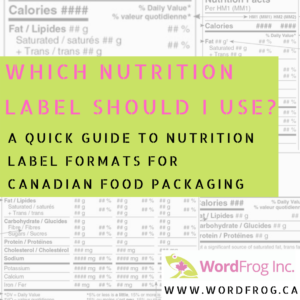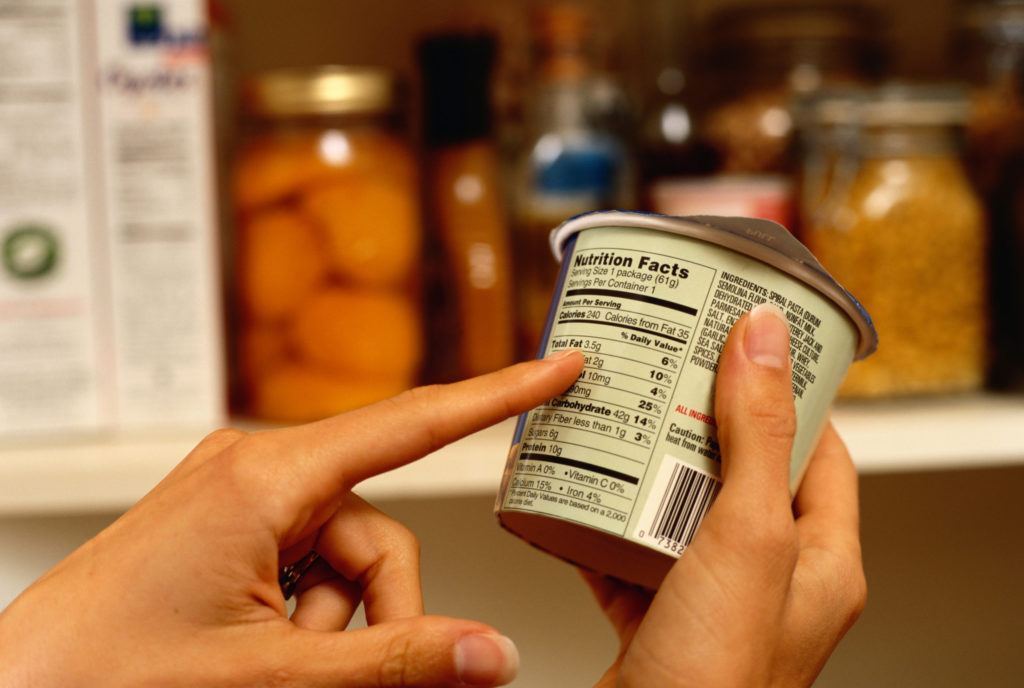
Welcome to my series on bilingual packaging for food products sold in Canada. In this first article, we’ll talk about the format of nutrition facts table that is appropriate to use for your specific product. I hope that these articles are useful in expanding your knowledge on Canadian packaging design requirements!
When designing food product packaging, it is imperative that you include a bilingual (English and French) nutrition label if the product is to be sold in Canada. But did you know that depending on the specifications and size of your design, you may have multiple nutrition table formats to choose from? Here are the six varieties that are most commonly used:

Bilingual Standard Nutrition Label
The standard vertical, rectangular nutrition table is the most common format that we see on food products sold in Canada. It may be presented in the normal-width or narrow standard format, and replaced with one of the formats below in cases where there is not enough vertical space to include it on the packaging design.
Bilingual Tabular/Horizontal Nutrition Label

The bilingual tabular format is appropriate to use in cases where the packaging does not have sufficient vertical space or a total space of less than 258 square centimeters (40 square inches). Visually speaking, there are no significant drawbacks to this option as the information is presented in the side-by-side format that consumers are used to.
Linear Nutrition Label


The linear nutrition label is essentially a condensed alternative to the bilingual tabular/horizontal format. It is appropriate to use in cases where the standard format label does not fit, and the tabular/horizontal label is not possible due to the shape of the packaging. According to Health Canada, the English and French versions of a linear nutrition label “may be displayed adjacent to one another within the same box”. The linear nutrition label is not as visually “clean” as the standard or tabular formats – however it may be used in a pinch if you are very limited by the shape of the item.

Bilingual Aggregate Nutrition Label
If the packaging contains multiple variations of a food product (i.e. variety pack, individual portions in multiple flavours, etc.), a bilingual aggregate nutrition label is your best bet. It allows you to list the different variations of the product in a clean fashion, without having to include multiple labels on the packaging. Note that this is only necessary for boxes containing a variety of individually packaged portions such as granola bars, oatmeal packets, single-serve cheeses, etc.)
Bilingual Dual Format Nutrition Label
The bilingual dual format nutrition label is appropriate to use in two cases:

1. Foods requiring preparation – the first column lists the information for the food as it comes in the box, while the second column would present information for the food “as prepared”. For example, this would be appropriate for macaroni and cheese (dry and as prepared) or a breakfast cereal (dry and with milk).

2. Foods with two possible serving sizes – It may be appropriate use the dual format label in cases where it could be assumed that the container is single-portion product, but in fact it contains more than one portion. For example, a food that may be used as both a condiment and a snack (such as apple sauce), or bread (where a serving is considered two slices).

Bilingual Simplified Standard Nutrition Label
The bilingual simplified nutrition label is a more compact and condensed version of the standard label. It may be used only in cases where the value for at least six (6) of the core nutrients is equal to zero. This format is most often used on drinks and drink mixes that contain very little nutrients (i.e. colas, sports drinks, etc.)
If you require specific specifications and size requirements, you will find this information in the official guides published by Health Canada, which are linked below:
Health Canada full-length guide to nutrition labelling requirements: https://www.canada.ca/en/health-canada/services/technical-documents-labelling-requirements/directory-nutrition-facts-table-formats/nutrition-labelling.html#a13
Government of Canada full-length guide to food labelling formats: https://www.inspection.gc.ca/food-label-requirements/labelling/industry/nutrition-labelling/nutrition-facts-table-formats/eng/1389209684841/1389210023155?chap=0
Stay tuned as I dive into other labelling-related topics, as an increased understanding of these requirements may lead to significant time and cost savings for you down the road!

